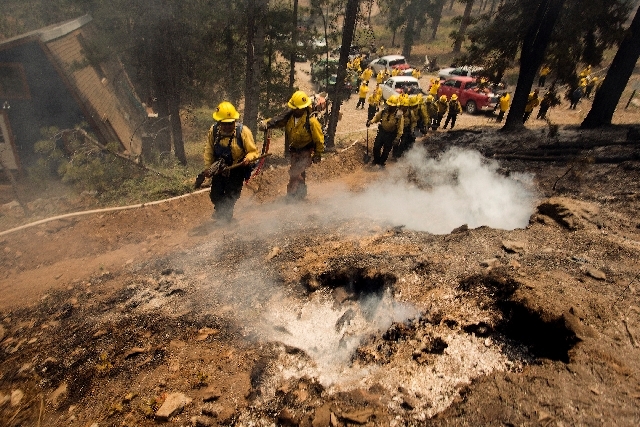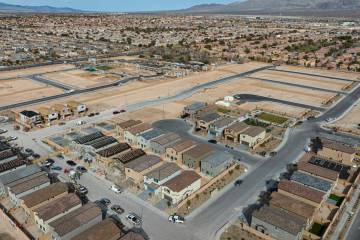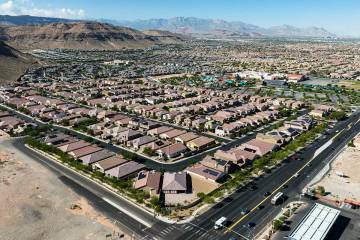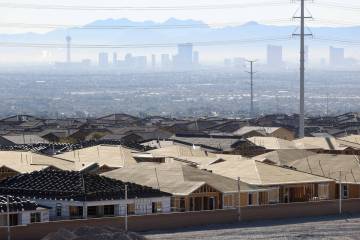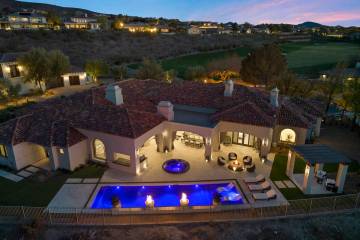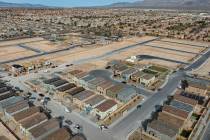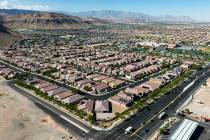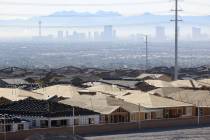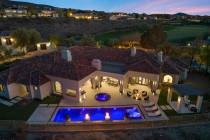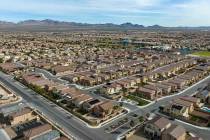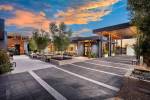Carpenter 1 wildfire may devalue homes in Spring Mountains
Edward Underhill and his dogs Ziggy and Foxy Lady returned to his Kyle Canyon cabin on Wednesday morning, after he had watched the fire roar from his home in Pahrump.
He and his neighbors have good reason to be thankful. Their homes escaped the flames of a forest fire that charred the mountains and forced the evacuation of Kyle Canyon.
But that doesn’t mean property owners will come out completely unscathed from the massive Carpenter 1 Fire that devastated about 28,000 acres of forest in the Spring Mountains.
Analyses of other wildfire-hit mountain communities in the West suggests he and his Mount Charleston neighbors might lose value — one expert’s studies of forest fires’ impact on property values in Colorado and Southern California found they can cause the sale prices of unburned houses to fall between 10 percent and 15 percent.
On the flip side, insurance rates could stay relatively unchanged, according to an industry trade group, the Nevada Insurance Council.
For Underhill, property values potentially dropping don’t concern him. He plans to keep his second home, which he has owned since 1991.
“It don’t matter to me because I’m not gonna get rid of it. They can lower all they want,” he said. “I just really like it up there. It’s an hour and a half, two hours maximum, from Pahrump. And when I was living in Vegas, it was half an hour away. Half an hour to get into a completely different environment is worth it. This is just one of those special things.”
PROPERTY VALUE DROP?
Two studies in Southern California and Colorado reached similar conclusions: that property values dropped after the fires.
Homes didn’t need to be in view of charred tree stumps and blackened mountainsides either, according to the study that looked at the impact of a Colorado fire that burned 12,000 acres and destroyed 12 houses. That study found a drop of 15 percent in property values, with the impact even reaching houses two miles away from the fire.
“People looked at those beautiful trees around their house differently evacuating or driving through the burned area,” said John Loomis, a professor at Colorado State University’s Department of Agricultural and Resource Economics, who published both studies in peer-reviewed journals. “They looked at those trees and went, ‘Yeah, they’re pretty but there’s also a higher risk.’ ”
The study on the Colorado fires was published in 2004, and the study on the Southern California fires was published in 2007.
A second fire could worsen property values. Loomis’ study of the impact of fires in Southern California found that the impact of the first fire on home prices was about 10 percent, with a second fire in the same area impacting prices by 23 percent. Firefighters are watching the Spring Mountains this weekend just in case a predicted storm system brings in more lightning, which was blamed for the Carpenter 1 Fire.
That study analyzed houses within 1.75 miles of fires, considering factors such as neighborhoods, the size of houses and inflation. Loomis also found that house prices recover from the setback within five to seven years.
ANSWERS NEXT YEAR
The impact on future property values on the mountain won’t be known until next year, according to the Clark County assessor’s office. It examines market sales when setting property values. That’s part of its annual process, said Rocky Steele, the assistant director of assessments.
The sales of homes on individual parcels in Mount Charleston have averaged $248,437 so far this year, excluding transactions involving multiple lots, according to data from the assessor’s office. That’s up from a low of $227,782 in 2012. The high was $553,750 in 2005.
Steele said it’s too soon to know what the outcome for that area will be.
Of course, lower property values also mean lower taxes. Owners who appeal the assessment of their property to the county next year can use real estate sales trends from July 1 to Jan. 1, 2014, when making their case for a lower valuation.
Garry Tomashowski, a real estate agent who lives in Mount Charleston and sells property there, said he’s hopeful the biggest impact will be the temporary inconvenience and scare of the fire.
“It appears that the lifestyle will remain intact, but of course, we were all threatened,” said Tomashowski, an owner of Mount Charleston Realty.
He said other factors, like upticks in interest rates, will play a stronger role than the fire in whether buyers get property at Mount Charleston.
“Honestly, I don’t believe it’s going to make a difference,” he said of the fire’s impact.
John Christopherson, natural resource program manager for the Nevada Division of Forestry, said the role fires play in increasing safety shouldn’t be overlooked. In some cases, low-intensity fires will remove fuels and increase the safety of the homes in the area, he said.
“All fires aren’t created equal,” he said. “No two fires are the same, nor are two areas of a fire.”
INSURANCE RATES HOLD STEADY
In general, property owners don’t need to worry about soaring insurance rates from the fire.
One reason is that the number of claims that will be filed is small, said Donna Fisher-Brown, secretary and treasurer of the Nevada Insurance Council.
The fire destroyed six structures, according to fire officials. None of those were in Kyle Canyon, the mountain’s population center. Insurance companies look at the number of claims in an area when setting rates, and a low number from one incident isn’t enough to impact rates, she said.
“Typically, insurance companies don’t have any type of a knee-jerk reaction to one incident,” she said.
Individual property owners can take steps to keep their rates lower, like clearing brush around their houses, she said.
Nevada’s already below average for insurance costs. In 2010, the average homeowner premium in the Silver State was $696, while the national average was $909, according to a study by the Insurance Information Institute, a New York-based organization. Neighboring Western states with a history of forest fires — Idaho, Utah and Oregon — had the lowest premium costs in the nation, that study shows.
PRICE OF PARADISE
Other property owners shrug off value changes, with no plans to sell.
Steve Ostrander, for example, bought his second home in Kyle Canyon in 2008.
For him, wildfires are part of the trade-off for having a vacation home in the mountains.
“This is unfortunately some of the prices you pay for living in paradise up here. I think for a lot of us, it’s a little more of an appreciation for the environment, being more cautious around the house and how we maintain the property,” he said.
Six years ago, Giles Hudson decided to buy a second home in Kyle Canyon to escape the heat with his two children and live in a completely different environment from Las Vegas.
“Who knows if anyone would buy or not anymore,” he said. “The fire is probably not going to make people happy, but it’s beautiful up there.”
Computer assisted reporting editor Brian Haynes contributed to this report. Contact reporter Melissah Yang at myang@reviewjournal.com or 702-383-0491. Follow her @MelissahYang. Contact reporter Ben Botkin at bbotkin
@reviewjournal.com or 702-405-9781. Follow him @BenBotkin1.




